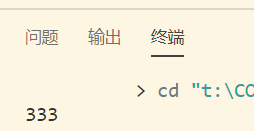- inline 函数避免函数调用的开销
- 定义并使用一个inline函数
1 #include <iostream> 2 using namespace std; 3 inline const string& longer(const string &s1, const string &s2) 4 { 5 return s1.size() > s2.size() ? s1 : s2; 6 } 7 int main() 8 { 9 string s1 = "222",s2 = "333"; 10 cout << longer(s1,s2); 11 return 0; 12 }
输出:

-
对于下面的声明和定义,你会将哪个放在头文件,哪个放 在程序文本文件呢?为什么? (a) inline bool eq(const BigInt&, const BigInt&) {...} (b) void putValues(int *arr, int size); (a)虽然是一个函数定义,但这是一个内联函数的定义,也应该放在头文件中。 因为:内联函数的定义对编译器而言必须是可见的,以便编译器能够在调用点 内联展开该函数的代码,这样一来,仅有函数原型是不够的;而且内联函数有 可能在程序中定义不止一次,这时必须保证在所有源文件中,其定义是完全相 同的。把内联函数的定义放在头文件中,可以确保在调用函数时所使用的定义 式相同的,并且保证在调用点该函数的定义对编译器是可见的。 (b)是函数声明,适合放于头文件中。
-
1 #include <iostream> 2 using namespace std; 3 4 int main() 5 { 6 string s1 = "222",s2 = "333"; 7 cout << longer(s1,s2); 8 return 0; 9 } 10 //把定义放在此处,无法执行程序,因为调用inlin函数时编译器并不知道该函数的定义 11 inline const string& longer(const string &s1, const string &s2) 12 { 13 return s1.size() > s2.size() ? s1 : s2; 14 }
如果是普通函数,会调到函数定义的地方执行,而内敛函数则是原地展开,必须马上知道其定义,所以应将定义放入头文件中,因为#include过了,所以可以知道定义